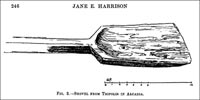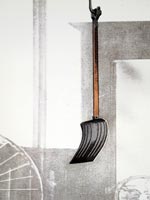|
In commenting on the term athereloigón (Lattimore 1965:11.128), an oracular periphrasis literally meaning consumer of chaff and translated as winnowing fan, Eustathius linked it to the ptyon, that is a shovel, and added that the analogy is explained by the fact that both the things compared are also identified with the blade – “the oar is the blade of the sea” and “the shovel the blade of the dry land” (Stallbaum 1826:403). Harrison claimed, “Such a word, suitable enough to the obscurity of an oracle, is obviously not one in common use; it is too cumbersome for daily handling; but none the less the main fact stands out clearly that it was an implement that could be carried over the shoulder, that roughly speaking it looked like an oar” (Harrison 1903:301-302). The winnowing fan in Homeric days was made of wood in such a shape that an oar could be mistaken for it. The contemporary spade-shaped shovel, bought by Mr R. C. Bosanquet at Tripolis in Arcadia [Fig. 4], rudely hewn out of the native fir, might easily be confused with a paddle-shaped oar (Harrison 1904:246). Servius describes the fan as “cribrum areale,” the sieve of the threshing floor. The function that the sieve and fan have in common is that they are both implements employed in the purifying of grain by winnowing (Harrison 1903:293). The difficult task of the winnower consists in using the fan to toss up from the threshing floor the mix of heavy grain and light chaff, so that, thus exposed to the wind or by their own specific gravity, the former would fall short in a growing heap while the latter would be carried to a distance. The contemporary spade-shaped shovel, bought by Mr R. C. Bosanquet at Tripolis in Arcadia [Fig. 4], rudely hewn out of the native fir, might easily be confused with a paddle-shaped oar (Harrison 1904:246). Servius describes the fan as “cribrum areale,” the sieve of the threshing floor. The function that the sieve and fan have in common is that they are both implements employed in the purifying of grain by winnowing (Harrison 1903:293). The difficult task of the winnower consists in using the fan to toss up from the threshing floor the mix of heavy grain and light chaff, so that, thus exposed to the wind or by their own specific gravity, the former would fall short in a growing heap while the latter would be carried to a distance.
 What is more, in the first book of Georgics, Virgil refers to the service of Ceres with the mystica vannus Iacchi (Georgics I.166). He calls it the mystic fan of Iacchus, because the rites of Father Liber had reference to the purification of the soul, and men are purified in his mysteries as grain is purified by fans (Harrison 1903:293). Considering the winnowing fan’s mystical extension, along with the Greek term’s aforementioned oracular quality, Duchamp may have found an ideal opportunity to make enigmatic reference to it with the snow shovel on which he inscribed the title, In Advance of the Broken Arm [Fig. 5], his first readymade after he moved to the United States, in 1915. This work has long been held to be self-referential. Duchamp’s fondness of reverberating puns encouraged later commentators to give the shovel a phallic interpretation with the title insinuating castration (The Société Anonyme and the Deier Bequest at Yale University 1984:244). What is more, in the first book of Georgics, Virgil refers to the service of Ceres with the mystica vannus Iacchi (Georgics I.166). He calls it the mystic fan of Iacchus, because the rites of Father Liber had reference to the purification of the soul, and men are purified in his mysteries as grain is purified by fans (Harrison 1903:293). Considering the winnowing fan’s mystical extension, along with the Greek term’s aforementioned oracular quality, Duchamp may have found an ideal opportunity to make enigmatic reference to it with the snow shovel on which he inscribed the title, In Advance of the Broken Arm [Fig. 5], his first readymade after he moved to the United States, in 1915. This work has long been held to be self-referential. Duchamp’s fondness of reverberating puns encouraged later commentators to give the shovel a phallic interpretation with the title insinuating castration (The Société Anonyme and the Deier Bequest at Yale University 1984:244).
|

